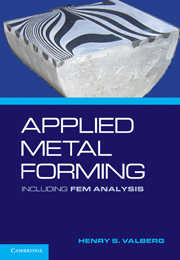Book contents
- Frontmatter
- Contents
- Preface
- APPLIED METAL FORMING
- 1 Characteristics of Metal Forming
- 2 Important Metal Forming Processes
- 3 FEA of Metal Forming
- 4 Theory
- 5 Reduction and Proportions of the Plastic Zone
- 6 Deformations from the Velocity Field
- 7 Technological Tests and Physical Simulation
- 8 Flow Stress Data
- 9 Formability and Workability
- 10 Friction and Friction Models
- 11 Thermal Effects
- 12 Experimental Metal Flow Analysis
- 13 Theoretical Methods of Analysis
- 14 Finite Element Analysis
- 15 FEA of Technological Tests
- 16 Forging
- 17 FEA of Forging
- 18 Extrusion
- 19 FEA of Extrusion
- 20 Rolling
- 21 FEA of Rolling
- 22 Drawing of Wire, Profiles, and Tubes
- 23 FEA of Wiredrawing
- 24 Sheet-Metal Forming
- Index
- References
20 - Rolling
Published online by Cambridge University Press: 05 June 2012
- Frontmatter
- Contents
- Preface
- APPLIED METAL FORMING
- 1 Characteristics of Metal Forming
- 2 Important Metal Forming Processes
- 3 FEA of Metal Forming
- 4 Theory
- 5 Reduction and Proportions of the Plastic Zone
- 6 Deformations from the Velocity Field
- 7 Technological Tests and Physical Simulation
- 8 Flow Stress Data
- 9 Formability and Workability
- 10 Friction and Friction Models
- 11 Thermal Effects
- 12 Experimental Metal Flow Analysis
- 13 Theoretical Methods of Analysis
- 14 Finite Element Analysis
- 15 FEA of Technological Tests
- 16 Forging
- 17 FEA of Forging
- 18 Extrusion
- 19 FEA of Extrusion
- 20 Rolling
- 21 FEA of Rolling
- 22 Drawing of Wire, Profiles, and Tubes
- 23 FEA of Wiredrawing
- 24 Sheet-Metal Forming
- Index
- References
Summary
Rolling is the metal forming process by which the largest amount of metal is being worked in the world. In terms of tonnage of metal, this process must therefore be considered the most important one. In Sec. 2.2.4, some important aspects of this forming process were discussed. In this chapter, some additional practical topics important in industrial rolling will be considered. The treatment will be limited to flat rolling; section rolling is outside the scope of this book.
The velocity conditions of the workpiece along the roll surface, through the roll gap, will first be considered. It will be shown that the velocity conditions here depend on whether there is sliding friction or sticking friction between the rolls and the workpiece. In industrial rolling, it is important to be able to estimate the loads acting on the rolls from the workpiece, i.e., to determine the required rolling force. Because of this, a large number of rolling force formulas have been developed over the time. One such simple formula will be considered in this chapter. Afterwards, it will be shown how the strain and strain-rate conditions vary throughout the roll gap, if one assumes homogeneous deformation in the workpiece material during rolling. In that case, a rectangular slab element of material that enters the roll gap should maintain its rectangular shape during passage through the gap.
- Type
- Chapter
- Information
- Applied Metal FormingIncluding FEM Analysis, pp. 365 - 375Publisher: Cambridge University PressPrint publication year: 2010



